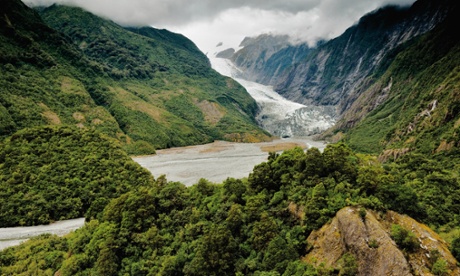New Zealand’s ‘dramatic’ ice loss could lead to severe decline of glaciers

Source: The Guardian
New Zealand’s vast Southern Alps mountain range has lost a third of its permanent snow and ice over the past four decades, diminishing some of the country’s most spectacular glaciers, new research has found.
A study of aerial surveys conducted by the National Institute of Water and Atmospheric Research (Niwa) discovered that the Southern Alps’ ice volume has shrunk by 34% since 1977.
Researchers from the University of Auckland and University of Otago said this “dramatic” decrease has accelerated in the past 15 years and could lead to the severe decline of some of New Zealand’s mightiest glaciers.
Glaciers, made up of ice that collects above the permanent snowline, have their size and shape altered by various conditions, such as temperature, wind and rainfall.
The Niwa data shows that New Zealand’s glaciers experienced three growth spurts during the 1970s and 1980s due to a change in the Pacific climate system that generated more wind. But since that wind circulation has returned to its previous state, rising global temperatures have caused the glaciers to retreat dramatically.
About 40% of the recorded ice loss has been in the dozen largest New Zealand glaciers, including the Tasman, Murchison and Maud glaciers. These huge slabs of ice and snow, supported by rock, take many years to respond to changing temperatures but are now collapsing, according to researchers.
“We are losing the bottom half of these large glaciers as they sink into lakes,” Trevor Chinn, a glaciologist at Niwa, told Guardian Australia. “We are also losing access to the upper glaciers. We used to be able to walk up them but it’s much harder now because the ridges are turning into gravel cliffs and they collapse.
“There’s been a tipping point where the glaciers melt down to the same level as the river bed. We started getting the first lakes from melting glaciers in the 1970s and they’ve all grown.
“It’s more or less decimated some of the tourist trips because people have so far to walk to the spectacular glaciers now. In the Mount Cook area, they used to have glacier tours and now they have lake tours to look at the floating icebergs.”
Chinn has been documenting the glaciers of the Southern Alps, a 450km stretch of mountains that runs along the spine of New Zealand’s south island, since the 1970s.
He said the delayed impact of rising temperatures is likely to shrink the glaciers even further.
“In the long term, the ice in the valleys will disappear,” he said. “We won’t lose glaciers until the snowline moves above the top of the mountain. At Mount Cook, it will take 15C to 20C of warming to do that, so we will still have glaciers, they will just be a lot smaller.
“The glaciers are responding to changes in the climate since 1890, so we are operating from a long way behind where we are. This decline will take decades.”
The collapse of New Zealand’s glaciers is part of a wider global trend, with the thickness of smaller glaciers decreasing by approximately 12m on average between 1961 and 2005.
This, in turn, will contribute to rising sea levels. Last year the Intergovernmental Panel on Climate Change stated that the melting of mountain glaciers has added around 6-7cm to sea levels since 1900. A further 10-20cm is expected to be added from glaciers by 2100.
Source: The Guardian








































































































































Global march against geo engineering September 27